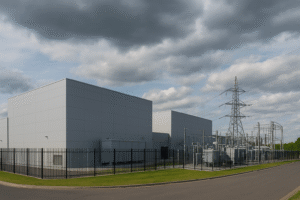The industrial energy sector is on the verge of a major transformation. CEEDS is set to break down the barriers around siloed and hard-to-access data. The Common European Energy Data Space isn’t just another new directive from Brussels; it’s the groundwork for a truly integrated, digital energy system. This initiative is changing the game for how businesses interact with the grid, their energy providers, and their competitors. If you ignore its implications today, it’s like overlooking the internet back in 1995. In this article, we’ll dive into the strategic framework of this new energy data space, offer a clear roadmap for integration, and explore the market it’s shaping for the future.
The Common European Energy Data Space Framework: From EU Mandate to New Market Reality
So, what is CEEDs when you get right down to it? Take it as a shift from the patchwork of local country rules to a single rulebook for information related to energy. Vital data has been locked up in proprietary systems for years. This makes the energy sector a little inefficient. So, this section talks about the fundamental architecture of the common energy data space. It will explain the strategic mindset and crucial new governance of the data:
Beyond the Data Act: How CEEDS Defines the Rules for Industrial Data Sharing
You most likely have heard about the EU Data Act. It gives the legal right to your data. That’s the “What,” and CEEDS is the “how.” So, the Data Act gives the key to the vault, but the common energy data space is what builds a standardized/secure highway system for the data to travel. Furthermore, it creates a trusted framework for data exchange. Today, if you want to share real-time data with a third-party analytics firm, it reflects a requirement of custom legal agreements/complex IT projects. Moreover, the energy data space replaces all that with a common set of rules/protocols. This means the access granting process to your consumption data will become as simple/secure as authorizing a payment with your online bank.
The “Common” in the Common European Energy Data Space: A Deep Dive into Interoperability
The magic word here stands to be “common,” and it all boils down to true interoperable energy data. Right now, it is like your factory in Germany is recording its data on a Blu-ray disc, while the grid operator in France only accepts VHS tapes. They simply don’t interact with one another. Additionally, the common energy data space. fixes this by ordering a universal language, the Common Information Model (CIM), for the entire domain of energy. This stands to be a major deal. It means even a small software company in Poland can make a cutting-edge predictive maintenance tool for your machinery, and it will work out-of-the-box for your complete European factory portfolio. That too, without the presence of a single line of custom code for each area.
Data Intermediaries: Your Gateway to Industrial Data Sharing within the CEEDS Ecosystem
You would not be connecting the sensitive control network of your factory to this massive energy data space. You will connect through a new kind of regulated company known as a “Data Intermediation Service.” Take them as the secure/neutral air traffic controllers for your energy information. They are the trusted couriers of your data. So, they do not need to own it; their entire job is to get your information where it needs to go, along with the correct permissions, and keep it locked down. Additionally, it puts you at a crucial crossroads:
- Do you partner with a well-known name who are trusted for its strong cybersecurity, or,
- Take a chance on a startup that is starting to push the edge through its built-in analytics
Who you choose will reflect how you play the game in this new market.
Phased Rollout: The Path to a Pan-European Common European Energy Data Space
The mega vision of executing a common energy data space won’t take place overnight. The plan for rollout is smart as it starts with what already works. A few countries, such as Denmark & Estonia, are way ahead on this path, so their first logical step is to connect their own national systems. Moreover, this will make regional data corridors that will, in turn, link up all the different electricity networks across the member states. When it comes to a multinational company, this implies you can strategically plan your integration. Additionally, for instance, if you have operations in the region of Benelux, you can start to prepare those sites now, knowing they will most probably be amongst the first to fully integrate into the CEEDS framework.
What CEEDS Means for Industrial Data Sharing: A Practical Roadmap to Integration
Now, let us go from the high-level strategy to the factory floor. A new framework tends to be of no use if you can’t connect to it. When it comes to plant managers/CFOs, this means executing solid steps to get your facilities ready. This section gives a no-fluff guide for any player within the energy sector to prepare for industrial data sharing/ chasing in new opportunities:
Preparing Your OT for Industrial Data Sharing: A CEEDS-Compliance Checklist
Your journey to EU Data Act & common energy data space compliance for industry begins with your equipment. Furthermore, there needs to be granular/real-time data to play in this new league. The first step is straightforward: put meters on the gear that eats the most power. Give a thought about your compressed air systems, HVAC, & even the big production lines. If you are adding solar panels right on-site, this step becomes even more crucial. This is because you need a solid sense of how everything goes together. Moreover, you also want to see, almost every minute, how much renewable energy you are producing vs using. This level of detail is also your entry ticket. Without this, you are just a spectator in the new energy system.
An Immediate Use Case: What CEEDS Means for Automated ESG Reporting
Here is an immediate/high-value win: fixing the horrors of ESG reporting. The Corporate Sustainability Reporting Directive (CSRD) wants audited/investment-grade data. Today, this means going after spreadsheets/manual readings. CEEDS promises to change that by making way for you to make a direct, automated pipeline of data right from your meters to the reporting software. Additionally, this gives a timestamped/verifiable/tamper-proof record of your energy use. For your CFO, this stands to be gold. It implies you can prove your green credentials to stakeholders/banks with solid data. This, in turn, unlocks great financing terms and also eliminates any greenwashing risk.
From Theory to Revenue: Leveraging the Common European Energy Data Space for Grid Services
Only the largest industrial players could make money through stabilizing local electricity networks till now. CEEDS tend to open that market to almost everyone. With increasing intermittent renewable energy coming online, our grids are becoming unstable. This makes flexibility, or the ability to reduce the use of energy briefly, extremely valuable. With a common energy data space, a medium-sized cold storage facility can now provide to pause its compressors for, let’s say, 15 minutes during a city-wide peak demand. Additionally, the grid operator looks at this offer in an open market, accepts it, and the facility also gets paid. So, you see your energy consumption just went from being a straightforward cost to a revenue-generating asset.
Performance Benchmarking: A Key Benefit of Industrial Data Sharing through CEEDS
Have you ever given a thought as to how your plant’s efficiency compares to that of your competitors? Soon enough, you would not have to guess. A critical feature of energy data space will be access to anonymized data from your specific industrial sector. This means a car parts manufacturer in, let’s say, Spain can benchmark its energy use per unit against the live average of all other car parts manufacturers in Europe. Furthermore, this kind of insight was not possible before. It gives way to spot any inefficiency you never knew existed. It also gives you an incredible business case to your board for investing in new/ more efficient technology.
The Future of Industrial Data Sharing: Navigating the Market Transformed by the Common European Energy Data Space (CEEDS)
Now it is time to look ahead. The use of a common energy data space will do more than just make things more efficient; it will essentially rewire the business models of the entire European energy market. It will make way for winners & losers. So, this section goes through the long-term changes that will drive from this new era of open industrial data sharing & rules of data governance:
The EaaS Revolution: How the Common European Energy Data Space (CEEDS) Will Reshape the Market
Prepare yourself for a complete disruption of the traditional utility model. The common energy data space will make way for a new wave of Energy-as-a-service by making secure/easy access to your data. These companies won’t just provide you with kilowatt-hours. They will make use of your data from the new data infrastructure to give you a fixed/all-inclusive service contract. For instance, they might promise a 15% reduction in your total energy bill in exchange for a flat fee each month. Furthermore, they take on the responsibility of installing/managing solar panels, batteries, & efficiency upgrades to deliver on the promise. So, this moves the whole market from selling a commodity to selling a guaranteed outcome.
The Security Challenge: What Secure Industrial Data Sharing Means in a CEEDS World
Let’s be clear on the security risks here. If you connect your factory’s control systems to an external network, it stands to be a high-stakes move. For years, your operational technology must be protected with a physical “air gap,” entirely separate from the IT world. That will is now being torn down for a purpose. This is not just another IT security task. Furthermore, a breach here is essentially different because it can make way for physical consequences. We are no longer just protecting information. We are also protecting industrial machinery/human safety. Moreover, an intruder can manipulate legacy protocols common in OT to cause issues in production or create unsafe conditions. So, this is a fundamental risk that moves the conversation from the server room to the boardroom.
Beyond Electricity: The Future Scope of the Common European Energy Data Space
The ultimate vision that the energy data space reflects goes far beyond electricity. The framework is made to handle data from the entire domain of energy. It includes:
- Natural gas,
- District heating,
- And the fast-growing green hydrogen market.
This is where sector coupling becomes a reality. Imagine a mega chemical plant is making use of CEEDS to make decisions in real-time. Sometimes the wind farms end up making way more power than the capacity of the grid. So, sometimes prices drop in such a situation. And instead of letting that power go to waste, the setup runs the electrolyzers harder, turns the extra into hydrogen, and, in turn, puts it aside for later. Such a back-and-forth between energy sources is what truly moves decarbonization.
The Strategic Dilemma: Balancing Data Sovereignty and Efficiency in Industrial Data Sharing
Now the question shifts: how much are you prepared to share? Playing in this new market isn’t about staying on the sidelines; it calls for real transparency. However, your energy consumption information can show a lot about your production schedules/operational health. Moreover, this has led to intense debates amongst member states about the right governance of data. Additionally, your company will need to make a clear strategy, deciding which data points give a competitive advantage when shared and which should remain private. It does not stand to be a mere IT issue; it is a core strategic decision in the new CEEDS-driven world.
To Sum Up
The launch of CEEDS tends to be a major change; it fundamentally restructures Europe’s industrial energy system. It reflects both a challenge and a massive opportunity for each company. The challenge tends to be making the necessary technical/security upgrades, while the opportunity is to unlock new revenue, drive crazy efficiency, and gain a competitive advantage. So, the path to implement a common energy data space in Europe is happening now & the companies that move first will set the standard and gain the biggest rewards. To get ahead of the curve, join your peers/the leaders driving this change at the 2nd Industrial Energy Management Summit this 8-9 October 2025 in Berlin, to build your strategy for the future.




